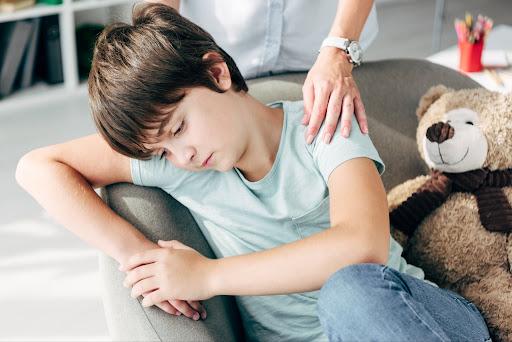It is estimated that 13-20 percent of children living in the U.S. experience a mental disorder in a given year.1 This includes mood disorders like depression, bipolar, dysthymia, and more. Find out what the most common mood disorders are in children and teens, signs to look out for, and treatment options that are available.
What Are the Most Common Mood Disorders?
According to the Children’s Hospital of Philadelphia, the most common mood disorders in children and adolescents are:
- Major depression: A depressed mood that lasts more than two weeks
- Dysthymia (Persistent depressive disorder): A chronic depressed mood that lasts a year or longer
- Bipolar disorder: Periods of elevated mood followed by stretches of depression
- Disruptive mood dysregulation disorder: Persistent irritability or the feeling of being out of control
- Premenstrual dysmorphic disorder: Symptoms of severe depression, intense irritability, and tension before menstruation
- Mood disorder triggered my medical condition: This can be caused cancer, injuries, or other traumatic medical conditions
- Substance-induced mood disorder: Depressive symptoms brought on by drug use, environmental toxins, or other substances
Mood Disorder or Underlying Mental Health Issue?
If your child is moody from time to time, it doesn’t necessarily mean that they are struggling with a mood disorder.2 Fluctuating hormones, social pressures, and worries about the future can all contribute to occasional mood swings that are absolutely normal. However, for some children and teens, mood disorders can be debilitating and the sign of an underlying mental health issue that needs attention. For instance, anxiety affects an estimated 4.4 million children in the U.S. and ADHD affects 6.1 million children; these are two conditions that can contribute to changes in mood and co-occur with a mood disorder.
Signs Your Child Could Have a Mood Disorder
Sometimes when a child or teen is struggling with a mood disorder, they may keep their symptoms to themselves. It’s important that parents take note of any changes in behavior to rule out a serious issue. Here are some signs that your child could have a mood disorder:3
- Persistent feelings of sadness, despair, helplessness, or guilt
- Low self-esteem
- Suicidal ideation
- Loss of interest or engagement in activities they once enjoyed
- Interpersonal conflicts with peers and/or family members
- Sleep issues, including insomnia
- Changes in appetite and weight
- Low energy
- Trouble making decisions
- Constant fatigue or physical complaints, such as headaches or upset stomach
- Threats of running away from home or other rebellious behavior
- Sensitivity to rejection
- Hostile behavior
- Poor academic performance
Social/Emotional and Environmental Effects on Mood
While imbalances in brain chemicals and genetics may contribute to your child or teen developing a mood disorder over the course of their lifetime, there may be other factors to consider. In one longitudinal study that followed participants over the course of seven decades, researchers found a link between adverse childhood environments and elevated risk for developing mood and anxiety disorders in adulthood.4 These adverse childhood experiences included maltreatment, family instability, and economic hardship. The study showed that such adverse childhood experiences are associated with dysregulation in the autonomic nervous system and the hypothalamic-pituitary-adrenal axis, leading to maladaptive emotional and social functioning. Children who have greater difficulties managing negative emotions are likely to be more emotionally reactive to environmental stressors.
How Technology Can Affect Your Child’s Mood
In some cases, daily habits like technology use can also affect your child’s mood, exacerbating symptoms of depression and low mood. According to a study published in JAMA Psychiatry, teenagers who spend more than three hours a day on social media are more likely to develop mental health problems including depression, anxiety, aggression, and antisocial behavior.5 Mayo Clinic pediatrician Dr. Angela Mattke points to a few reasons why technology and social media may be contributing to a rise in depression amongst children and teens. She says, “They're watching everyone else's Instagram, but they’re not engaging and, so, they're losing out on that social connection.”6 Furthermore, electronic screens can disrupt sleep, which she says may also contribute to a depressed mood, moodiness and irritability.
Treatment Options
If you suspect your child is struggling with a mood disorder, you may want to visit your family doctor for a physical exam to rule out serious health conditions that could be affecting their mood. You may also find benefit in having your child see a therapist or counselor.
While some families choose to treat their child’s mood disorder with prescription medication, others may be deterred by the side effects that often come with these medications, such as drowsiness, dry mouth, and nausea. Another option for easing symptoms that may be affecting your child’s mood such as stress, irritability, and restlessness, is Brillia. A non-prescription, homeopathic medication, Brillia offers a gentle and impactful approach to reducing anxiety and improving attention and focus without harsh chemicals or harmful side effects. Unlike most prescription medications that use powerful synthetic chemicals, Brillia’s active ingredient is not synthetic. It is an antibody to the brain-specific S100 protein (S100B), an important regulator of various different intracellular and extracellular brain processes. This protein functions by binding to targets in the brain to produce symptoms of anxiety and ADHD. Brillia works by attaching to the S100B protein and regulating its activity without destroying, modifying, or changing its concentration. This efficiently stops it from producing these undesirable symptoms. Because this is achieved in a targeted manner, no other systems in the body are affected and no harmful side effects are triggered.
Brillia works best in tandem with healthy lifestyle factors that may also support a healthy mood. In addition to securing a treatment plan with your child’s doctor or counselor, ensure they are following a nutritious diet, getting enough sleep, limiting screen time and practicing mindfulness and relaxation techniques.
Learn more about how Brillia works here.
Erica Garza is an author and essayist from Los Angeles. She holds an MFA from Columbia University and a certificate in Narrative Therapy. Her writing has appeared in TIME, Health, Glamour, Good Housekeeping, Women's Health, and VICE.


 Improve focus and clarity.
Improve focus and clarity.

